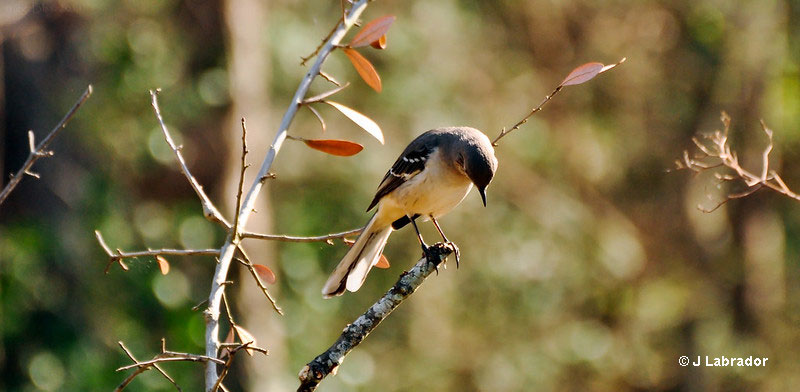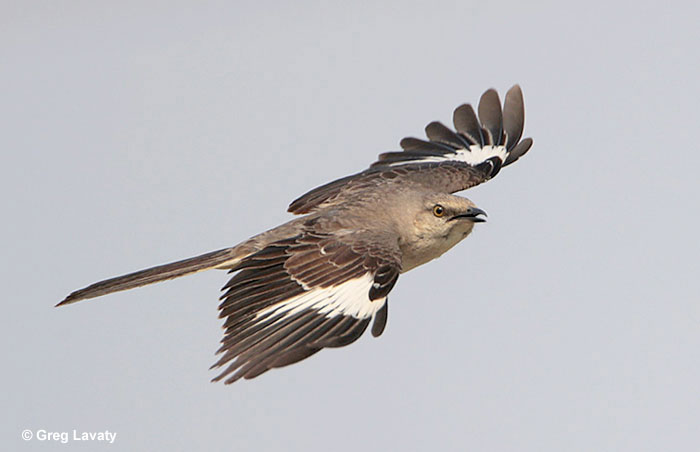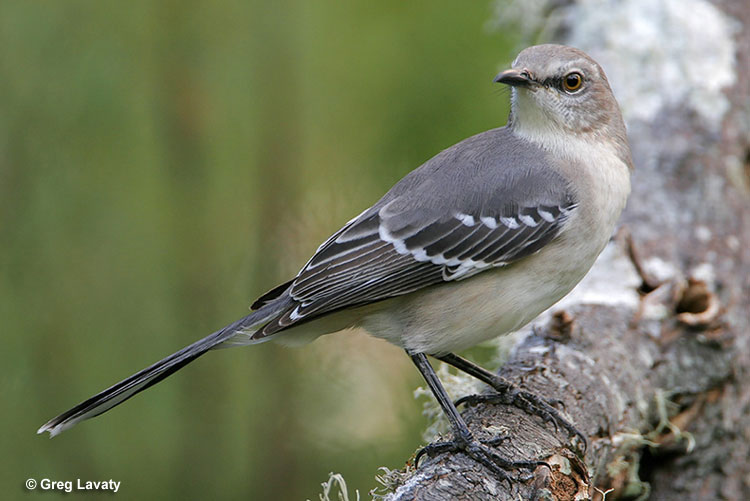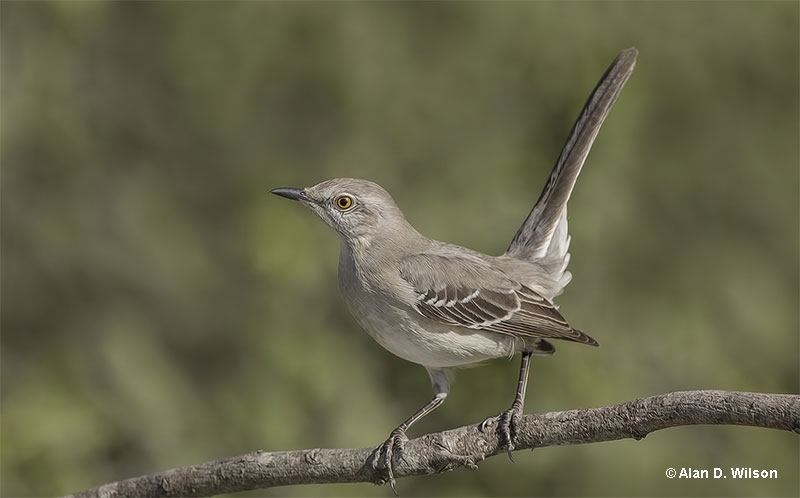
Tennessee is a southern state with 42,143 square miles of rolling woodlands, cypress swamps, farmlands, urban areas, and other habitats. More than seven million people call The Volunteer State home. They also have the good fortune of sharing these beautiful lands with more than 420 bird species!
Tennessee state bird, the Northern Mockingbird, is an endearing bird whose impressive and cheerful vocalizations are heard in every corner of the state!
On this page
Texas State Bird
The Northern Mockingbird (Mimus polyglottos) became the state bird of Tennessee on April 19th, 1933. On this date, the state legislature picked this bird species after passing Tennessee Senate Joint Resolution number 51.
During the early 1930s, Federated Women’s Clubs were campaigning to encourage states to pick official state symbols, including a state bird. In Tennessee, they worked with garden clubs and the Tennessee Ornithological Society to suggest some good avian candidates and help organize a vote.
These organizations also coordinated with the State Department of Education, Superintendents of Schools, the State Department of Agriculture, and the Division of Game and Fish to educate the public about choosing a good state bird.

Not long after, on April 11th, 1933, a vote was held, and more than 70,000 people cast ballots. Although there was support for the American Robin, Northern Cardinal, and Northern Bobwhite, the Northern Mockingbird received the most votes.
A week later, Tennessee lawmakers made the results official, and the Northern Mockingbird became the state bird.
It’s no surprise that this vocal species was picked to be a state symbol. In Tennessee, Northern Mockingbirds are common and familiar throughout the state. It’s also a much-liked bird (although maybe not when it sings in the middle of the night!).
Fun Facts about Northern Mockingbirds
- The Northern Mockingbird plays an important role in Harper Lee’s novel To Kill a Mockingbird. In this classic book, the birds are seen as a symbol of innocence.
- Northern Mockingbirds are amazing mimics. They can imitate the songs of more than 200 other bird species and even imitate car alarms and cell phones!
- At one time, this species was heavily trapped and traded for caged songbird competitions! The best singers were coveted and worth hundreds of dollars. Fortunately, trading stopped in 1918 after mockingbirds became protected by the Migratory Bird Treaty Act.
- This bird species is fairly famous. It has been a well-known and popular bird for hundreds of years and has been featured in books, movies, and songs.
- When Northern Mockingbirds forage, they often open and close their wings. These movements flash big white patches that might scare insects out of hiding. They may also be associated with territorial displays and trying to scare off predators.
- The Northern Mockingbird is one of several related mockingbird species. Most live in South America and do not have the Northern Mockingbird’s impressive mimicking abilities.
- In addition to Tennessee, this species is also the state bird of Florida, Arkansas, and Texas. One of the reasons why it was chosen in Texas was because, “like any true Texan”, the Northern Mockingbird fights to protect its home.
- Around their nests, Northern Mockingbirds are very defensive and can swoop at cats, dogs, and people who venture too close!
- This species is quite intelligent. Studies have shown that they can recognize people’s faces, especially if they consider someone to be a threat.
- In the past, Northern Mockingbirds only lived in the southern USA. However, the introduced Asian Multiflora Rose and a warming climate have helped them expand north.
Identification
The Northern Mockingbird is a robin-sized, slender songbird with fairly long, dark legs. It is pale gray above and buff-white below and has two white wing bars and a white patch on each wing.
Northern Mockingbirds also have a long dark gray tail with bright white outer feathers, a rather short dark beak, and a dark line through their eyes.
With a close look, we can also see that mockingbirds have narrow white crescents above and below their pale yellow eyes.

Both sexes of the Northern Mockingbird look the same, although males are a bit bigger and weigh around 1.7 ounces. Female mockingbirds tend to weigh 1.6 ounces. On average, males and females are 10 inches long, have a 14-inch wingspan, and are nearly impossible to tell apart.
Juvenile Northern Mockingbirds resemble adults but have faint spotting on their underparts, a larger pale mark on their beaks, and can have more white or less white on their wings.
Although we usually see these birds on an open lawn or singing from a prominent perch, they also fly with several flaps followed by a brief glide. During flight, the white in their rounded wings and long tail become obvious field marks.
What do Northern Mockingbirds eat?
Northern Mockingbirds eat many types of insects, berries, and other small fruits. They feed on bugs like caterpillars, beetles, crickets, grasshoppers, and most other insects that they manage to catch.
In general, Northern Mockingbirds catch more insects and bugs during spring and summer and eat more berries during the winter.
In some places, fruit is just about the only thing they eat during the winter.
These birds usually forage for insects by standing on a lawn, golf course, or other open spot with short grass. They look around, and when they spot an insect, they quickly swoop or hop over to catch it. If a mockingbird doesn’t notice food, it may hop or run a short distance and watch from another spot.
While doing this, they can open and close their wings to scare insects out of hiding. Northern Mockingbirds also watch for insect prey from low perches. When they see a bug, they swoop down to catch it or even fly into the air to snatch the insect in flight.
This species forages for berries by flying into a bush and picking the fruit with its beak. They feed on a wide variety of fruits, including Stranger Figs and Multiflora Rose.
Call
Northern Mockingbirds are best known for their impressive singing capabilities. Their songs vary but always consist of warbled phrases and repeated snatches of mimicked bird vocalizations.
It usually pauses for two to three seconds between phrases, and the song sounds something like, “treedle treedle treedle….chirip chirip chirip….tiditiditiditiditidi…treedle treedle…”. Mimicked bird species can include the Tufted Titmouse, Northern Flicker, Blue Jay, Carolina Wren, and many others!
These vociferous birds can sing for several minutes at a time, over and over.
The Northern Mockingbird also makes harsh “check” calls. This abrupt vocalization is usually heard while the bird is flying or foraging.
Behavior
Northern Mockingbirds are bold birds that tend to be obvious and easy to see. They prefer open areas with scattered bushes and short grass. In other words, they love places that many people also love: habitats like golf courses, parks, and neighborhoods with big, open lawns.
We might see them at the edge of the forest, but not usually inside wooded areas.
These vocal birds can sing any time of day or night, especially during spring and early summer! When singing, they usually pick a prominent spot like a bush, tree, or rooftop. Such perches can be particularly unfortunate when the birds sing at 3 a.m., right next to a bedroom window!

During singing downtime, Northern Mockingbirds forage for bugs on open lawns or for berries in bushes and trees. Although they are common around houses, they don’t usually visit feeders.
While feeding on berries, this species tends to be aggressive towards other birds and often chases them away from its food source.
When Northern Mockingbirds nest, they also become aggressive and can dive and swoop at any animal they perceive as a threat. This can include everything from other birds to cats, dogs, and even people!
Keep reading: Most common birds of Tennessee & Hawks in Tennessee
Frequently Asked Questions
What is the state bird of Tennessee?
The state bird of Tennessee is the Northern Mockingbird.
Why is the Northern Mockingbird the state bird of Tennessee?
The Northern Mockingbird is the state bird of Tennessee because it is a much appreciated, common, and well-known bird throughout the state.
When did Tennessee choose its state bird?
Tennessee chose its state bird on April 19th, 1933.
What is Tennessee’s state animal?
Tennessee’s state animal is the Raccoon.
What is the state flower of Tennessee?
The state flower of Tennessee is the Purple Passionflower. The state cultivated flower is the Iris.

